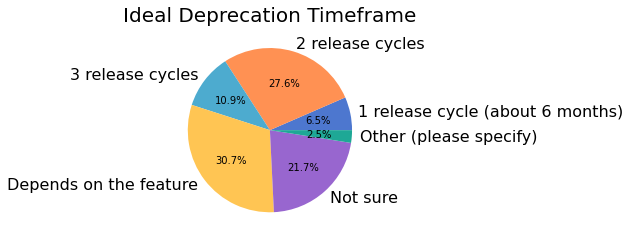使用¶
fname = "data/2021/numpy_survey_results.tsv"
column_names = [
'version', 'version_other', 'primary_use','use_freq','components','use_c_ext',
'using_random', 'bug', 'bug_resolution', 'bug_resolution_other',
'unsolvable', 'unsolvable_resolution', 'unsolvable_resolution_other',
'issues','issues_other',
'deprecation_short', 'deprecation','deprecation_other'
]
featdep_dtype = np.dtype({
"names": column_names,
"formats": ['U1024'] * len(column_names),
})
data = np.loadtxt(
fname, delimiter='\t', skiprows=3, dtype=featdep_dtype,
usecols=[22,23,24,28,29,30,73,74,75,76,77,78,79,80,81,82,83,84], comments=None, encoding='UTF-16'
)
本节包含各种问题,旨在深入了解新功能采用、问题解决和弃用周期的时长等方面。
NumPy 主要用途¶
418 (80%) 受访者提供了他们使用 NumPy 的主要场景信息。近四分之三的受访者在工作中使用了 NumPy。
uses = data['primary_use'][data['primary_use'] != '']
labels, cnts = np.unique(uses, return_counts=True)
fig, ax = plt.subplots(figsize=(12, 8))
ax.pie(cnts, labels=labels, autopct='%1.1f%%')
ax.set_title("NumPy Primary Use");
fig.tight_layout()
glue(
'2021_num_primary_use_respondents',
gluval(uses.shape[0], data.shape[0]),
display=False
)
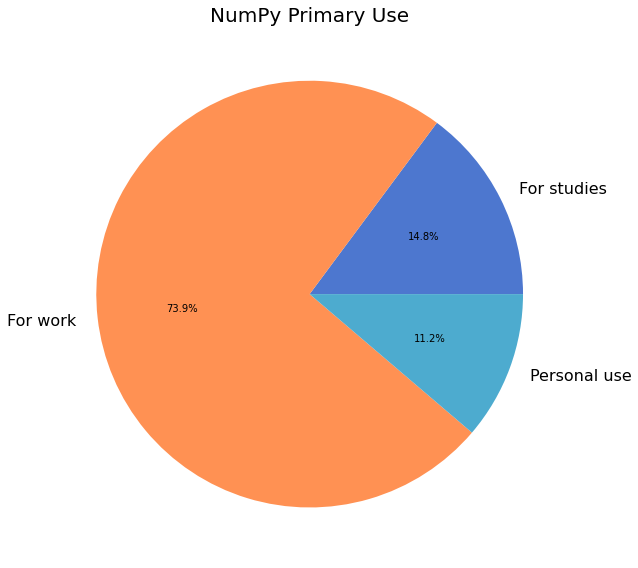
NumPy 使用频率¶
418 (80%) 受访者提供了他们使用 NumPy 的频率信息。大多数受访者每天或每周使用 NumPy。
use_freq = data['use_freq'][data['use_freq'] != '']
labels, cnts = np.unique(use_freq, return_counts=True)
fig, ax = plt.subplots(figsize=(12, 8))
ax.pie(cnts, labels=labels, autopct='%1.1f%%')
ax.set_title("NumPy Frequency of Use");
fig.tight_layout()
glue('2021_num_freq_respondents', gluval(use_freq.shape[0], data.shape[0]), display=False)
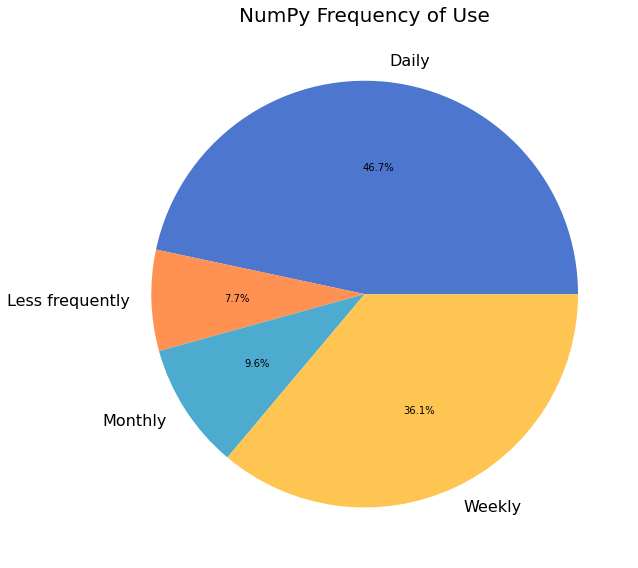
NumPy 版本¶
调查进行时,NumPy 1.21 是最新的稳定版本。50.7% 的受访者表示他们主要使用旧版本的 NumPy。
vers = data['version'][data['version'] != '']
labels, cnts = np.unique(vers, return_counts=True)
fig, ax = plt.subplots(figsize=(12, 8))
ax.pie(cnts, labels=labels, autopct='%1.1f%%')
ax.set_title("NumPy Version");
fig.tight_layout()
# Percentage of users that use older versions
older_version_usage = 100 * cnts[-8:-2].sum() / cnts.sum()
glue('2021_older_version_usage', f"{older_version_usage:1.1f}", display=False)
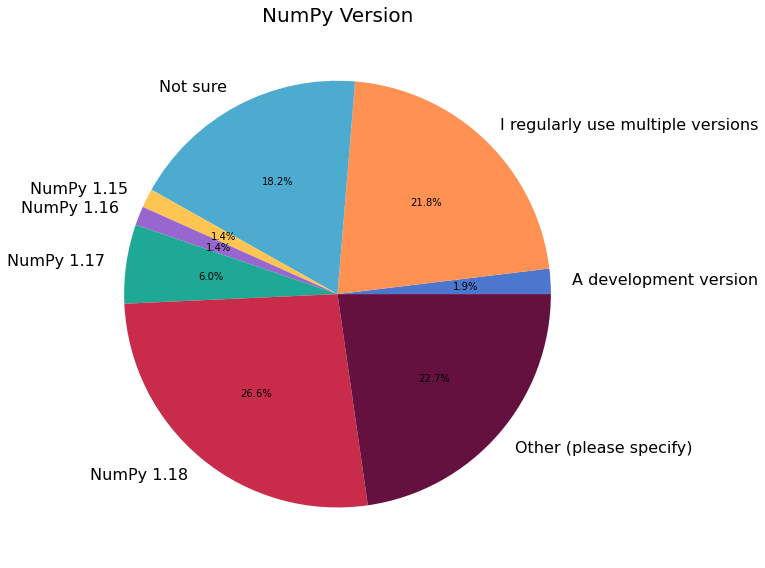
NumPy 组件¶
NumPy 包含许多用于特定科学计算任务的包,例如随机数生成或傅里叶分析。下图显示了报告使用每个 NumPy 子包的受访者百分比。
components = data['components'][data['components'] != '']
num_respondents = len(components)
# Process components field
all_components = []
for row in components:
all_components.extend(row.split(','))
all_components = np.array(all_components)
labels, cnts = np.unique(all_components, return_counts=True)
# Descending order
I = np.argsort(cnts)
labels, cnts = labels[I], cnts[I]
cnts = 100 * cnts / num_respondents
fig, ax = plt.subplots(figsize=(12, 8))
ax.barh(np.arange(len(cnts)), cnts, align='center')
ax.set_yticks(np.arange(len(cnts)))
ax.set_yticklabels(labels)
ax.set_xlabel("Percentage of Respondents")
ax.set_title("Use-Frequency of NumPy Sub-Packages")
fig.tight_layout()

NumPy C 扩展¶
363 (70%) 参与者分享了他们(或其组织)是否通过 NumPy C-API 使用自定义 C 扩展(不包括 Cython)。只有大约 7% 的受访者表示有使用。
uses_c_ext = data['use_c_ext']
use_c_ext = data['use_c_ext'][data['use_c_ext'] != '']
labels, cnts = np.unique(uses_c_ext, return_counts=True)
labels[0] = 'No response'
fig, ax = plt.subplots(figsize=(8, 8))
ax.pie(cnts, labels=labels, autopct='%1.1f%%')
ax.set_title("Use of NumPy C-Extentions");
fig.tight_layout()
glue('2021_num_c_ext', gluval(use_c_ext.shape[0], data.shape[0]), display=False)
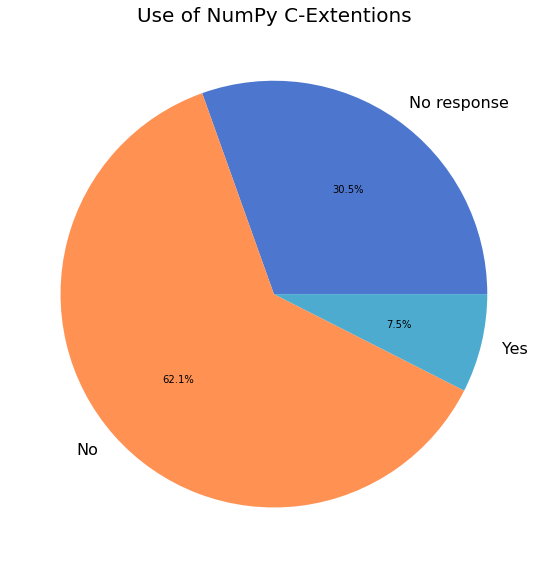
新 numpy.random 采用情况¶
一个新的随机数生成 API 被添加到 numpy.random 的 1.17 版本中。我们询问了调查参与者是否正在使用新的随机 API。在 522 名调查参与者中,233 (45%) 分享了他们是否正在使用新的 random API。
rand = data['using_random'][data['using_random'] != '']
labels, cnts = np.unique(rand, return_counts=True)
fig, ax = plt.subplots(figsize=(8, 8))
ax.pie(cnts, labels=labels, autopct='%1.1f%%')
ax.set_title("Use of Random API");
fig.tight_layout()
glue(
'2021_num_random_users',
gluval(rand.shape[0], data.shape[0]),
display=False
)
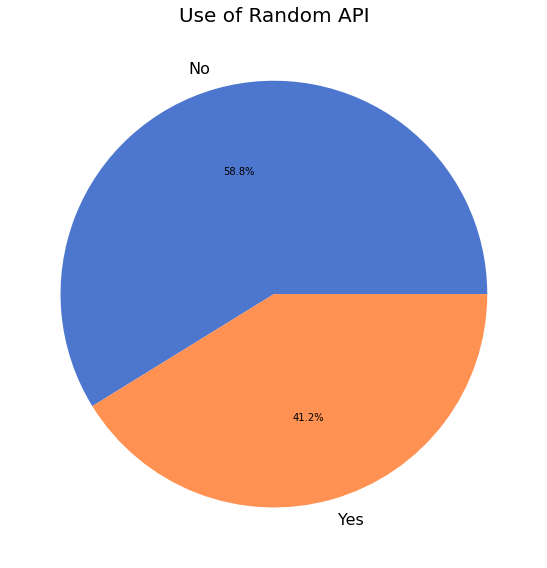
处理问题¶
我们想了解用户遇到 NumPy 问题有多频繁,因此我们提出了以下问题
在过去一年中,您是否遇到过由 NumPy 问题导致的自己编写的代码中的问题?
在 522 名调查参与者中,331 (63%) 回答了这个问题。
bug = data['bug'][data['bug'] != '']
labels, cnts = np.unique(bug, return_counts=True)
fig, ax = plt.subplots(figsize=(8, 8))
ax.pie(cnts, labels=labels, autopct='%1.1f%%', labeldistance=None)
ax.legend()
ax.set_title("Experienced NumPy Issues");
fig.tight_layout()
glue(
'2021_bug_reporters',
gluval(bug.shape[0], data.shape[0]),
display=False,
)

我们询问了那些报告遇到问题的人,他们采取了哪些行动来解决问题。
bug_resolution = data['bug_resolution'][data['bug_resolution'] != '']
labels, cnts = np.unique(flatten(bug_resolution), return_counts=True)
I = np.argsort(cnts)
labels, cnts = labels[I], cnts[I]
fig, ax = plt.subplots(figsize=(12, 8))
ax.barh(
np.arange(len(labels)),
100 * cnts / bug_resolution.shape[0],
tick_label=labels,
)
ax.set_xlabel('Percentage of Respondents')
ax.set_title("Actions to Resolve NumPy Issue");
fig.tight_layout()
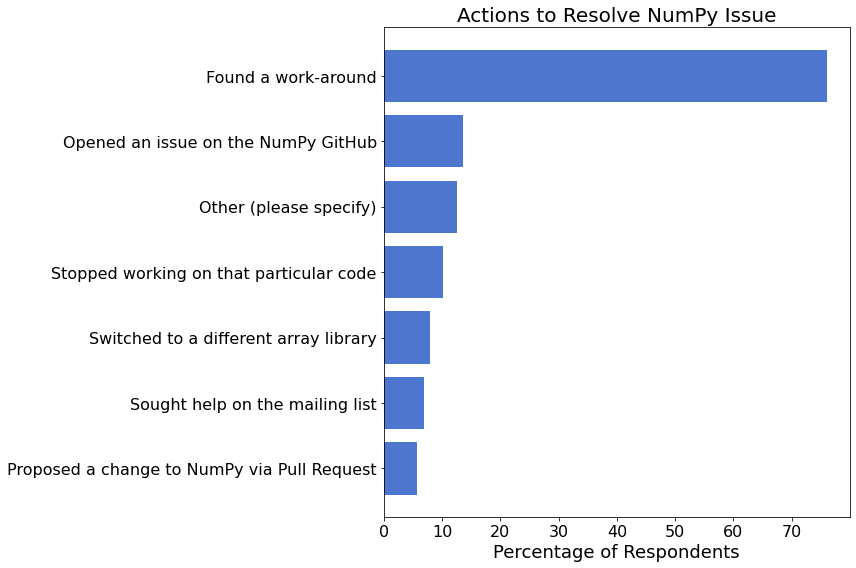
使用 NumPy 进行数据分析¶
与上一个问题类似,我们试图了解 NumPy 如何满足用户的数据分析需求。我们提出了以下问题
在过去一年中,您是否遇到过无法使用 NumPy 解决的涉及数值数据的问题?
在 522 名调查参与者中,328 (63%) 回答了上述问题,其中 60 (18%) 报告称他们遇到了一个最初预期能够使用 NumPy 解决但未能解决的问题。
unsolvable = data['unsolvable'][data['unsolvable'] != '']
labels, cnts = np.unique(unsolvable, return_counts=True)
num_yes = np.sum(unsolvable == 'Yes')
fig, ax = plt.subplots(figsize=(8, 8))
ax.pie(cnts, labels=labels, autopct='%1.1f%%')
ax.set_title("Experienced Data Analysis Issues");
fig.tight_layout()
glue(
'2021_num_solvers',
gluval(unsolvable.shape[0], data.shape[0]),
display=False,
)
glue(
'2021_num_unsolved',
gluval(num_yes, unsolvable.shape[0]),
display=False
)

我们询问了那些对上一个问题回答“是”的人,他们采取了哪些行动来解决问题。
resolution = data['unsolvable_resolution'][data['unsolvable'] == 'Yes']
resolution = resolution[resolution != '']
labels, cnts = np.unique(flatten(resolution), return_counts=True)
I = np.argsort(cnts)
labels, cnts = labels[I], cnts[I]
fig, ax = plt.subplots(figsize=(12, 8))
ax.barh(
np.arange(len(labels)),
100 * cnts / resolution.shape[0],
tick_label=labels,
)
ax.set_xlabel('Percentage of Respondents')
ax.set_title("Actions to Resolve Data Analysis Issue");
fig.tight_layout()
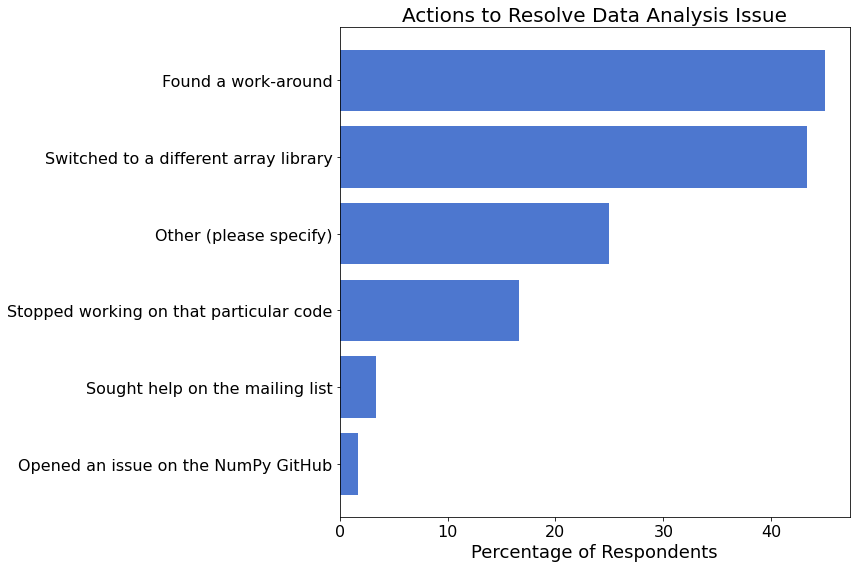
提出问题¶
54 (10%) 受访者报告称他们遇到了无法使用 NumPy 解决的数值数据问题,但没有提出问题。随后,我们询问了他们为什么没有针对其特定问题提出问题。
open_issues = data['issues'][data['issues'] != '']
labels, cnts = np.unique(flatten(open_issues), return_counts=True)
I = np.argsort(cnts)
labels, cnts = labels[I], cnts[I]
fig, ax = plt.subplots(figsize=(12, 8))
ax.barh(
np.arange(len(labels)),
100 * cnts / open_issues.shape[0],
tick_label=labels,
)
ax.set_xlabel('Percentage of Respondents')
ax.set_title("Reason for not opening issue");
fig.tight_layout()
glue(
'2021_num_open_issues',
gluval(open_issues.shape[0], data.shape[0]),
display=False,
)
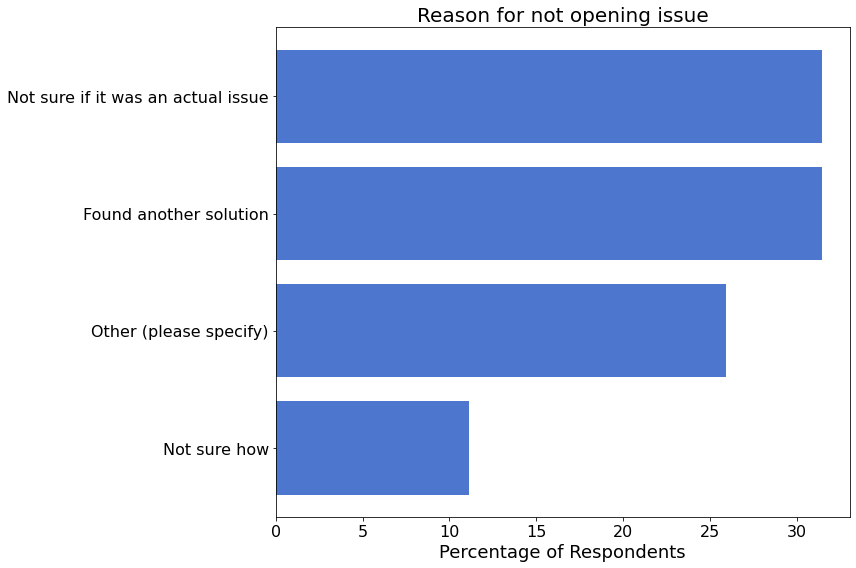
弃用时间范围¶
我们请调查参与者分享他们对 NumPy 弃用周期的看法,具体来说是
NumPy 通常采用两个发布周期(1 年)的弃用策略。您认为这…
在 522 名调查参与者中,322 (62%) 回答了这个问题。
current_dep = data['deprecation_short'][data['deprecation_short'] != '']
labels, cnts = np.unique(current_dep, return_counts=True)
fig, ax = plt.subplots(figsize=(8, 8))
ax.pie(cnts, labels=labels, autopct='%1.1f%%')
ax.set_title("Viewpoint on NumPy Deprecation Timeframe");
fig.tight_layout()
glue(
'2021_num_dep_short',
gluval(current_dep.shape[0], data.shape[0]),
display=False
)
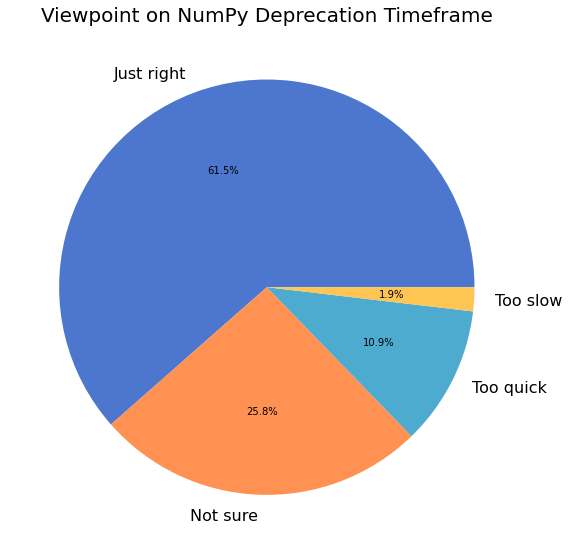
我们还提出了以下问题
您认为一个好的弃用时间范围是多久?
在 522 名调查参与者中,322 (62%) 回答了这个问题。
depcycle = data['deprecation'][data['deprecation'] != '']
labels, cnts = np.unique(depcycle, return_counts=True)
fig, ax = plt.subplots(figsize=(8, 8))
ax.pie(cnts, labels=labels, autopct='%1.1f%%')
ax.set_title("Ideal Deprecation Timeframe");
fig.tight_layout()
glue(
'2021_dep_opinions',
gluval(depcycle.shape[0], data.shape[0]),
display=False
)
